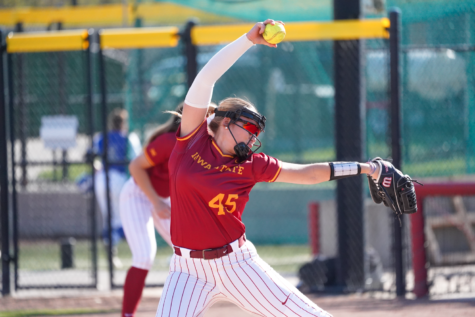TRACK AND FIELD: Jumpers find success away from spotlight
April 21, 2009
Through all of the hustle and bustle of the ISU track and field workouts, it might be easy to misplace the small group of jumpers and multi-event athletes.
While the other groups are running circles or yelling and cheering for their teammates, this group keeps to their own. They quietly go about their business, something quite different from the rest of the team.
“It’s different — it’s a lot different — but it works,” said assistant coach Pete Herber, who has led the group for the last two seasons.
On this day, a regular Monday afternoon, there were never more than five athletes under Herber’s supervision.
This workout began with three pole vault competitors who went through speed training and plyometric workouts. The vault group, along with the rest of the groups, alternate between so-called speed days and technique days to cover all aspects of their complex events.
Then, a little later in the afternoon, the workout began for two high jumpers in two very different spots in their career.
Sophomore Tiffanie Synacek is a seasoned veteran in only her second outdoor season and has already competed in an NCAA Outdoor Championship in her brief career. But her training partner was freshman Kelsey Petersen who most recently saw action in 23 matches for the Cyclone volleyball team.
“[Petersen] was a two-time state champion in Nebraska, and came to us a couple of months ago and wanted to start high-jumping,” Herber said. “She’s been working with us a couple of times a week, just trying to get back into the swing of things and getting some technique down.”
Synacek often helps work with young jumpers like Petersen by giving Herber another set of eyes on each trial run. That is something that isn’t exclusive to Synacek, but rather it is something that is expected from all of the jumpers.
Herber said communication is key for the success of his group because he cannot watch all aspects of his team at one time. At any given time there may be athletes working on the high jump, long jump, and plyometrics simultaneously.
“I may be at a completely different angle, so I might not see what they can see from someplace else,” Herber said. “It’s important that everybody understand the concepts we talk about, first of all, but also how to communicate those concepts to each other and myself.”
However, with so much going on at one time, there are things the coach can do to allow a chance for each group to get the attention they need.
Throughout the Monday afternoon workout, different clusters of athletes wandered to the infield at intervals of about an hour. Herber’s day started at 1:30 p.m., but was not over until the final group of high jumpers finished shortly after 6 p.m.
“When it comes to technique days, we try to stagger as much as we can,” Herber said after the long afternoon. “Those are pretty much the only day we have to do that, because then Tuesday we’ll come back in and primarily be on the same type of training.”
During the workout for both the high jumpers and long jumpers, a small wooden ramp was brought out and placed in front of the mat as a sort of launching pad for the athletes’ takeoffs.
Herber said this ramp gets the athletes comfortable spending more time in the air, which can make them more comfortable clearing higher marks. He also said it helps with body positioning that is important regardless of the event they are training for.
That body positioning is key, also, for the multi-event athletes such as freshman Jordon Andreassen and sophomore Kale Brockmann who use similar techniques in each event.
“We have a really young group,” Herber said. “If we get the body position right and get them feeling comfortable with one event, we can always say ‘If you feel this here, this is how it should feel in this other event.’”
















